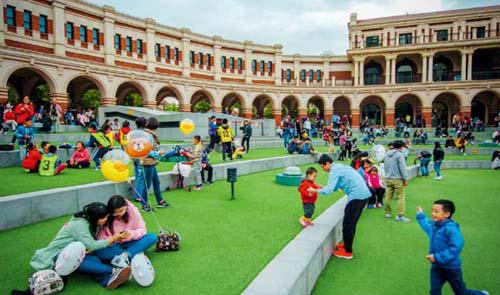New Chinese Consumption for a New Era
2018-11-26byLinJiang
by Lin Jiang

Generally speaking, a consumption upgrade reflects a countrys consumption level and spending evolution. Since the beginning of Chinas reform and opening up in the late 1970s, the countrys consumption structure has been upgraded three times, driving industrial structure upgrade and fueling high-speed economic growth.
The first consumption upgrade happened soon after the beginning of Chinas reform and opening up. At that time, expenditures on grain dropped while consumption on light industrial products rose. This change facilitated the rapid development of related industries and brought about Chinas first round of economic growth since the countrys reform and opening up.
The second consumption upgrade took place from the late 1980s to the late 1990s. In those days, bicycles, wrist watches and radios, known as the “three treasured household possessions” of the 1960s and 1970s, were replaced by refrigerators, color TV sets and washing machines. This consumption trend drove the second round of economic growth.
Today, China is undergoing the third consumption upgrade. The fastest-growing fields include education, entertainment, culture, transportation, telecommunications, healthcare, real estate, and tourism, especially spending related to IT, automobiles and real estate.
More Diverse Consumption
Since the beginning of Chinas reform and opening up, the ratio of Chinese spending on livelihood to the total consumption has been decreasing. Chinas Engels coefficient, a major indicator of living standards, dropped to 29.3 percent in 2017 from 63.9 percent in 1978. Spending on development and leisure is rising quickly, and consumption of services has witnessed fast development. In recent years, fields such as tourism, transportation, telecommunications, education, entertainment, culture, and healthcare have become new consumption hot spots which are driving the upgrade of residential consumption patterns.
Alongside the rapid growth in spending, Chinese residents have become more mature and diverse in terms of consumption psychology and behavior. Recently, the Chinese government issued Suggestions on Improving Systems and Mechanisms for Stimulating Consumption to Promote Spending Potentials of Residents. The document clarified key fields and direction of the countrys consumption upgrade and outlined plans to promote spending on goods and services, nurture new consumption modes and boost consumption upgrading in rural areas.
New Trends for Consumption
With the arrival of the internet era, the demands of Chinese residents have changed. Previously, most Chinese consumers followed broader trends and mimicked their peers. Now, their consumption patterns have become more diversified and personalized, focusing on quality goods and services. New consumption demands and patterns are emerging every day. Greater attention on brands and consumption quality will be the highlight of the consumption upgrade in China in the near future.
Considering the demographic shift since Chinas introduction of the nationwide two-child policy in 2015, related consumption soared. Youngsters born in the 1990s, which account for 16 percent of Chinas total population, are becoming new engines for the countrys consumption upgrade. It is estimated that from now until 2030, they will contribute more than 20 percent of the countrys consumption growth.
The current new outbreak of technological revolution in China including the mobile internet, big data, cloud computing and artificial intelligence will prompt a new batch of consumption growth points. Further development of the “internet+” economy and digital economy will deeply influence traditional consumption realms, driving and promoting the upgrade of traditional consumption fields.
Improved consumption concepts will make online spending more international, personalized and financialized. From “saving for spending” to “borrowing for spending,” the changing consumption ideas of Chinese residents have boosted the rise of e-commerce and shifted consumption demands. The entertainment and leisure sectors such as movies, gaming and tourism will continue to have robust consumption growth into the future.
Finally, Chinas rural vitalization strategy and the acceleration of its new type of urbanization will vigorously promote consumption upgrade in rural areas. The countrys fight against pollution will funnel consumption towards low-carbon, green, and environmentally friendly modes.
Market with Huge Potential
The Chinese economy is now entering a phase of high-quality development. Alongside the constant increase in their income, Chinese peoples spending power is growing. Chinas domestic market, with a population of nearly 1.4 billion, is developing at a high speed. In 1978, per capita disposable income in China stood at only 171 yuan. This figure soared to nearly 26,000 yuan in 2017 and is now marching towards 30,000 yuan. In the next 20 years, Chinas middle-income population will jump to 630 million from the current 230 million, which is bound to serve as the primary force for the countrys consumption upgrade.
Compared to developed countries, China still has plenty of room for consumption upgrade. In general, the service industry in developed countries accounts for more than 70 percent of GDP, and the final consumption rate stands at more than 65 percent, with the United States even exceeding 70 percent. In 2017, Chinas service industry accounted for 51.6 percent of its total GDP and its final consumption rate measured 53.6 percent, leaving huge room for spending on services.
The trend towards an aging society is transforming China into the worlds most promising market for senior care industries. According to the 2014 Report on the Development of Chinas Silver Industry, by 2050, Chinas elderly population will reach 480 million, accounting for nearly 25 percent of the worlds total. By then, the country will be home to the largest elderly population on the planet. From 2014 to 2050, the total spending of Chinas elderly people is expected to grow to 106 trillion yuan from four trillion yuan, accounting for 33 percent of the countrys GDP from the previous eight percent. In the “silver economy,” consumer demand for senior-related industries such as finance, healthcare, tourism and real estate will be huge.